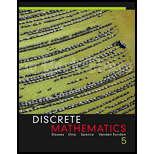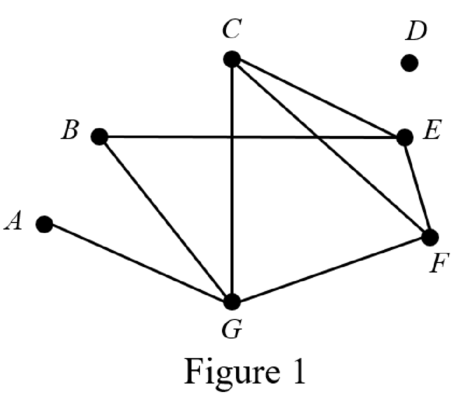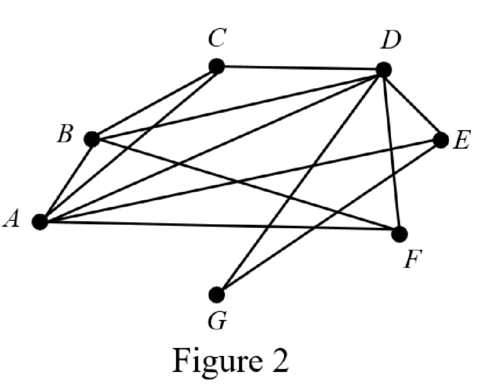
Discrete Mathematics
5th Edition
ISBN: 9780134689562
Author: Dossey, John A.
Publisher: Pearson,
expand_more
expand_more
format_list_bulleted
Question
Chapter 4, Problem 1SE
To determine
The complement of the given multi graph.
Expert Solution & Answer
Explanation of Solution
Let G be a given graph.
Label the vertices of the given graph as follows.

The complement of the graph above is can be constructed as below.
As per the definition given, the vertices are retained as it is.
The vertices A and B does not have an edge in Figure 1 and hence, in Figure 2, there is an edge in between A and B.
Similarly proceeding, the complement of the graph G is obtained as shown below in Figure 2.

Figure 2 is the complement graph of G.
Want to see more full solutions like this?
Subscribe now to access step-by-step solutions to millions of textbook problems written by subject matter experts!
Students have asked these similar questions
Prove that
1) | RxX (T) | << = (R₁ " + R$)
2) find Laplalse trans.
of Normal dis:
3) Prove thy t
/Rx (z) | < | Rx (0)\
4) show that evary
algebra is algebra
or not.
=
5 37
A 4 8 0.5
06
9
For each of the time series, construct a line chart of the data and identify the characteristics of the time series (that is, random, stationary, trend, seasonal, or cyclical).
Month Number (Thousands)Dec 1991 65.60Jan 1992 71.60Feb 1992 78.80Mar 1992 111.60Apr 1992 107.60May 1992 115.20Jun 1992 117.80Jul 1992 106.20Aug 1992 109.90Sep 1992 106.00Oct 1992 111.80Nov 1992 84.50Dec 1992 78.60Jan 1993 70.50Feb 1993 74.60Mar 1993 95.50Apr 1993 117.80May 1993 120.90Jun 1993 128.50Jul 1993 115.30Aug 1993 121.80Sep 1993 118.50Oct 1993 123.30Nov 1993 102.30Dec 1993 98.70Jan 1994 76.20Feb 1994 83.50Mar 1994 134.30Apr 1994 137.60May 1994 148.80Jun 1994 136.40Jul 1994 127.80Aug 1994 139.80Sep 1994 130.10Oct 1994 130.60Nov 1994 113.40Dec 1994 98.50Jan 1995 84.50Feb 1995 81.60Mar 1995 103.80Apr 1995 116.90May 1995 130.50Jun 1995 123.40Jul 1995 129.10Aug 1995…
Chapter 4 Solutions
Discrete Mathematics
Ch. 4.1 - In Exercises 1–4, list the set of edges and set of...Ch. 4.1 - Prob. 2ECh. 4.1 - Prob. 3ECh. 4.1 - Prob. 4ECh. 4.1 - Prob. 5ECh. 4.1 - In Exercises 5–8, draw a diagram representing the...Ch. 4.1 - Prob. 7ECh. 4.1 - In Exercises 5–8, draw a diagram representing the...Ch. 4.1 - Prob. 9ECh. 4.1 - In Exercises 9–14, determine whether a graph is...
Ch. 4.1 - Prob. 11ECh. 4.1 - Prob. 12ECh. 4.1 - Prob. 13ECh. 4.1 - Prob. 14ECh. 4.1 - Prob. 15ECh. 4.1 - Prob. 16ECh. 4.1 - Prob. 17ECh. 4.1 - Draw the graph with ν = {1, 2, … , 10} as its set...Ch. 4.1 - Prob. 19ECh. 4.1 - Prob. 20ECh. 4.1 - Prob. 21ECh. 4.1 - Show that there are an even number of vertices...Ch. 4.1 - Prob. 23ECh. 4.1 - Prob. 24ECh. 4.1 - Prob. 25ECh. 4.1 - Prob. 26ECh. 4.1 - Prob. 27ECh. 4.1 - In Exercises 26–29, find the adjacency matrix and...Ch. 4.1 - Prob. 29ECh. 4.1 - In Exercises 30 and 31, construct the graph for...Ch. 4.1 - Prob. 31ECh. 4.1 - In Exercises 32 and 33, construct the graph for...Ch. 4.1 - Prob. 33ECh. 4.1 - Prob. 34ECh. 4.1 - Prob. 35ECh. 4.1 - In Exercises 35-37, can each matrix be an...Ch. 4.1 - Prob. 37ECh. 4.1 - Prob. 38ECh. 4.1 - Prob. 39ECh. 4.1 - Prob. 40ECh. 4.1 - Prob. 41ECh. 4.1 - Are the pairs of graphs in (a), (b), and (c)...Ch. 4.1 - Are the pairs of graphs in (a), (b), and (c)...Ch. 4.1 - Draw all the non isomorphic graphs with three...Ch. 4.1 - Prob. 45ECh. 4.1 - Draw all the nonisomorphic graphs with five...Ch. 4.1 - Prob. 47ECh. 4.1 - Prob. 48ECh. 4.1 - Prob. 49ECh. 4.1 - Suppose a graph has n vertices, each with degree...Ch. 4.1 - Prob. 51ECh. 4.1 - Prob. 52ECh. 4.1 - Suppose Mr. and Mrs. Lewis attended a bridge party...Ch. 4.1 - Prove that if a graph has at least two vertices,...Ch. 4.2 - In Exercises 1–4, determine whether the multigraph...Ch. 4.2 - Prob. 2ECh. 4.2 - Prob. 3ECh. 4.2 - Prob. 4ECh. 4.2 - Prob. 5ECh. 4.2 - Prob. 6ECh. 4.2 - Prob. 7ECh. 4.2 - Prob. 8ECh. 4.2 - Prob. 9ECh. 4.2 - In Exercises 9 and 10, perform the following...Ch. 4.2 - Prob. 11ECh. 4.2 - Prob. 12ECh. 4.2 - Prob. 13ECh. 4.2 - Prob. 14ECh. 4.2 - Prob. 15ECh. 4.2 - Prob. 16ECh. 4.2 - Prob. 17ECh. 4.2 - In Exercises 18–23, determine whether the...Ch. 4.2 - Prob. 19ECh. 4.2 - In Exercises 18–23, determine whether the...Ch. 4.2 - Prob. 21ECh. 4.2 - In Exercises 18–23, determine whether the...Ch. 4.2 - Prob. 23ECh. 4.2 - In Exercises 24–29, determine whether the...Ch. 4.2 - Prob. 25ECh. 4.2 - Prob. 26ECh. 4.2 - Prob. 27ECh. 4.2 - Prob. 28ECh. 4.2 - Prob. 29ECh. 4.2 - Prob. 30ECh. 4.2 - Prob. 31ECh. 4.2 - Prob. 32ECh. 4.2 - Prob. 33ECh. 4.2 - Prob. 34ECh. 4.2 - Prob. 35ECh. 4.2 - Prob. 36ECh. 4.2 - Prob. 37ECh. 4.2 - An old childhood game asks children to trace a...Ch. 4.2 - Prob. 39ECh. 4.2 - In 1859, Sir William Rowan Hamilton, a famous...Ch. 4.2 - Give examples of connected graphs satisfying each...Ch. 4.2 - Prob. 42ECh. 4.2 - Prob. 43ECh. 4.2 - Prob. 44ECh. 4.2 - Prob. 45ECh. 4.2 - Prob. 46ECh. 4.2 - Prob. 47ECh. 4.2 - Prob. 48ECh. 4.2 - Prob. 49ECh. 4.2 - Are the following two graphs isomorphic? Justify...Ch. 4.2 - Prob. 51ECh. 4.2 - A bipartite graph is a graph in which the vertices...Ch. 4.2 - Prob. 53ECh. 4.2 - Prob. 54ECh. 4.2 - Prob. 55ECh. 4.2 - Prob. 56ECh. 4.2 - Prob. 57ECh. 4.2 - Prob. 58ECh. 4.2 - Prob. 59ECh. 4.2 - Prob. 60ECh. 4.2 - Prob. 61ECh. 4.2 - Prob. 62ECh. 4.2 - Prob. 64ECh. 4.2 - Prob. 65ECh. 4.3 - In Exercises 1–4, use the breadth-first search...Ch. 4.3 - In Exercises 1–4, use the breadth-first search...Ch. 4.3 - Prob. 3ECh. 4.3 - In Exercises 1–4, use the breadth-first search...Ch. 4.3 - In Exercises 5–8, determine the distance from S to...Ch. 4.3 - In Exercises 5–8, determine the distance from S to...Ch. 4.3 - Prob. 7ECh. 4.3 - Prob. 8ECh. 4.3 - Prob. 9ECh. 4.3 - Prob. 10ECh. 4.3 - Prob. 11ECh. 4.3 - Prob. 12ECh. 4.3 - Prob. 13ECh. 4.3 - Prob. 14ECh. 4.3 - For the following graph, determine the number of...Ch. 4.3 - Prob. 16ECh. 4.3 - Prob. 17ECh. 4.3 - Prob. 18ECh. 4.3 - Prob. 19ECh. 4.3 - Prob. 20ECh. 4.3 - Prob. 21ECh. 4.3 - Prob. 22ECh. 4.3 - Prob. 23ECh. 4.4 - In Exercises 1–8, find the chromatic number of the...Ch. 4.4 - Prob. 2ECh. 4.4 - Prob. 3ECh. 4.4 - Prob. 4ECh. 4.4 - Prob. 5ECh. 4.4 - Prob. 6ECh. 4.4 - Prob. 7ECh. 4.4 - Prob. 8ECh. 4.4 - Prob. 9ECh. 4.4 - Prob. 10ECh. 4.4 - Prob. 11ECh. 4.4 - It might be supposed that if a graph has a large...Ch. 4.4 - Prob. 13ECh. 4.4 - Prob. 15ECh. 4.4 - Prob. 16ECh. 4.4 - Prob. 17ECh. 4.4 - Prob. 18ECh. 4.4 - Prob. 19ECh. 4.4 - Suppose is a graph with three vertices. How many...Ch. 4.4 - Prob. 21ECh. 4.4 - Prob. 22ECh. 4.4 - Prob. 23ECh. 4.4 - Prob. 24ECh. 4.4 - Prob. 25ECh. 4.4 - Prob. 26ECh. 4.4 - Prob. 27ECh. 4.4 - Prob. 28ECh. 4.4 - Prob. 29ECh. 4.4 - Prob. 30ECh. 4.4 - Prob. 31ECh. 4.4 - Prob. 32ECh. 4.4 - Prob. 33ECh. 4.4 - Show that it is possible to assign one of the...Ch. 4.4 - Prob. 35ECh. 4.4 - Prove Theorem 4.9 by mathematical induction on the...Ch. 4.4 - Suppose that each vertex of a graph is such that...Ch. 4.5 - In Exercises 1–4, list the vertices and directed...Ch. 4.5 - Prob. 2ECh. 4.5 - Prob. 3ECh. 4.5 - Prob. 4ECh. 4.5 - Prob. 5ECh. 4.5 - Prob. 6ECh. 4.5 - Prob. 7ECh. 4.5 - Prob. 8ECh. 4.5 - Prob. 9ECh. 4.5 - Prob. 10ECh. 4.5 - Prob. 11ECh. 4.5 - Prob. 12ECh. 4.5 - Prob. 13ECh. 4.5 - Prob. 14ECh. 4.5 - Prob. 15ECh. 4.5 - Prob. 16ECh. 4.5 - Prob. 17ECh. 4.5 - Prob. 18ECh. 4.5 - Prob. 19ECh. 4.5 - Prob. 20ECh. 4.5 - Prob. 21ECh. 4.5 - Prob. 22ECh. 4.5 - Prob. 23ECh. 4.5 - Prob. 24ECh. 4.5 - Prob. 25ECh. 4.5 - Prob. 26ECh. 4.5 - Prob. 27ECh. 4.5 - Prob. 28ECh. 4.5 - Prob. 29ECh. 4.5 - Prob. 30ECh. 4.5 - Prob. 31ECh. 4.5 - Prob. 32ECh. 4.5 - Prob. 33ECh. 4.5 - Prob. 34ECh. 4.5 - Prob. 35ECh. 4.5 - Prob. 36ECh. 4.5 - Prob. 37ECh. 4.5 - Prob. 39ECh. 4.5 - Prob. 40ECh. 4.5 - Prob. 41ECh. 4.5 - Prob. 42ECh. 4.5 - Prob. 43ECh. 4.5 - Prob. 44ECh. 4.5 - Prob. 45ECh. 4.5 - Prob. 46ECh. 4.5 - Prob. 47ECh. 4.5 - Prob. 48ECh. 4.5 - Prob. 49ECh. 4.5 - Prob. 51ECh. 4.5 - Prob. 52ECh. 4.5 - Prob. 53ECh. 4.5 - Prob. 54ECh. 4.5 - Prob. 55ECh. 4.5 - Prob. 56ECh. 4.5 - Prob. 57ECh. 4.5 - Prob. 58ECh. 4.5 - Prob. 59ECh. 4.5 - Prob. 60ECh. 4.5 - Write a breadth-first search algorithm for...Ch. 4.5 - Prob. 62ECh. 4.5 - Prob. 63ECh. 4.5 - Prob. 64ECh. 4.5 - Prob. 65ECh. 4.5 - Prob. 66ECh. 4.5 - Prob. 67ECh. 4.5 - In Exercises 67–70, determine the distance from S...Ch. 4.5 - In Exercises 67–70, determine the distance from S...Ch. 4.5 - Prob. 70ECh. 4.5 - Prob. 71ECh. 4.5 - Prob. 72ECh. 4.5 - Prob. 73ECh. 4.5 - Prob. 74ECh. 4.5 - Prob. 75ECh. 4.5 - Determine whether the following pairs of directed...Ch. 4.5 - Determine whether the following pairs of directed...Ch. 4.5 - Prob. 78ECh. 4.5 - Prob. 79ECh. 4.5 - Prob. 80ECh. 4.5 - Prob. 82ECh. 4.5 - Prob. 83ECh. 4.5 - Prob. 84ECh. 4 - Prob. 1SECh. 4 - Prob. 2SECh. 4 - Prob. 3SECh. 4 - Prob. 4SECh. 4 - Prob. 5SECh. 4 - Prob. 6SECh. 4 - Prob. 7SECh. 4 - Prob. 8SECh. 4 - Prob. 9SECh. 4 - Prob. 10SECh. 4 - Prob. 11SECh. 4 - Prob. 12SECh. 4 - Prob. 13SECh. 4 - Prob. 14SECh. 4 - Is the property “is connected” a graph isomorphism...Ch. 4 - Prob. 16SECh. 4 - Prob. 17SECh. 4 - Prob. 18SECh. 4 - Prob. 19SECh. 4 - Prob. 20SECh. 4 - Prob. 21SECh. 4 - Prob. 22SECh. 4 - Prob. 23SECh. 4 - Prob. 24SECh. 4 - Prob. 25SECh. 4 - Prob. 26SECh. 4 - Prob. 28SECh. 4 - Prob. 29SECh. 4 - Prob. 30SECh. 4 - Prob. 31SECh. 4 - Prob. 32SECh. 4 - Prob. 34SECh. 4 - Prob. 35SECh. 4 - Prob. 36SECh. 4 - Prob. 37SECh. 4 - Prob. 38SECh. 4 - Prob. 39SECh. 4 - Prob. 40SECh. 4 - Prob. 6CPCh. 4 - Prob. 9CPCh. 4 - Prob. 14CP
Knowledge Booster
Similar questions
- For each of the time series, construct a line chart of the data and identify the characteristics of the time series (that is, random, stationary, trend, seasonal, or cyclical). Year Month Units1 Nov 42,1611 Dec 44,1862 Jan 42,2272 Feb 45,4222 Mar 54,0752 Apr 50,9262 May 53,5722 Jun 54,9202 Jul 54,4492 Aug 56,0792 Sep 52,1772 Oct 50,0872 Nov 48,5132 Dec 49,2783 Jan 48,1343 Feb 54,8873 Mar 61,0643 Apr 53,3503 May 59,4673 Jun 59,3703 Jul 55,0883 Aug 59,3493 Sep 54,4723 Oct 53,164arrow_forwardConsider the table of values below. x y 2 64 3 48 4 36 5 27 Fill in the right side of the equation y= with an expression that makes each ordered pari (x,y) in the table a solution to the equation.arrow_forwardsolving for xarrow_forward
- Consider the table of values below. x y 2 63 3 70 4 77 5 84 Fill in the right side of the equation y= with an expression that makes each ordered pari (x,y) in the table a solution to the equation.arrow_forwardfind the value of each variablearrow_forwardConsider the following system of equations, Ax=b : x+2y+3z - w = 2 2x4z2w = 3 -x+6y+17z7w = 0 -9x-2y+13z7w = -14 a. Find the solution to the system. Write it as a parametric equation. You can use a computer to do the row reduction. b. What is a geometric description of the solution? Explain how you know. c. Write the solution in vector form? d. What is the solution to the homogeneous system, Ax=0?arrow_forward
- 2. Find a matrix A with the following qualities a. A is 3 x 3. b. The matrix A is not lower triangular and is not upper triangular. c. At least one value in each row is not a 1, 2,-1, -2, or 0 d. A is invertible.arrow_forwardFind the exact area inside r=2sin(2\theta ) and outside r=\sqrt(3)arrow_forwardHigh Cholesterol: A group of eight individuals with high cholesterol levels were given a new drug that was designed to lower cholesterol levels. Cholesterol levels, in milligrams per deciliter, were measured before and after treatment for each individual, with the following results: Individual Before 1 2 3 4 5 6 7 8 237 282 278 297 243 228 298 269 After 200 208 178 212 174 201 189 185 Part: 0/2 Part 1 of 2 (a) Construct a 99.9% confidence interval for the mean reduction in cholesterol level. Let a represent the cholesterol level before treatment minus the cholesterol level after. Use tables to find the critical value and round the answers to at least one decimal place.arrow_forward
- Please could you explain how to do integration by parts for this question in detail pleasearrow_forwardThere were 426 books sold in one week. The number of biology books sold was 5 times that of the number of psychology books. How many books each were sold?arrow_forwardI worked out the answers for most of this, and provided the answers in the tables that follow. But for the total cost table, I need help working out the values for 10%, 11%, and 12%. A pharmaceutical company produces the drug NasaMist from four chemicals. Today, the company must produce 1000 pounds of the drug. The three active ingredients in NasaMist are A, B, and C. By weight, at least 8% of NasaMist must consist of A, at least 4% of B, and at least 2% of C. The cost per pound of each chemical and the amount of each active ingredient in one pound of each chemical are given in the data at the bottom. It is necessary that at least 100 pounds of chemical 2 and at least 450 pounds of chemical 3 be used. a. Determine the cheapest way of producing today’s batch of NasaMist. If needed, round your answers to one decimal digit. Production plan Weight (lbs) Chemical 1 257.1 Chemical 2 100 Chemical 3 450 Chemical 4 192.9 b. Use SolverTable to see how much the percentage of…arrow_forward
arrow_back_ios
SEE MORE QUESTIONS
arrow_forward_ios
Recommended textbooks for you
 Discrete Mathematics and Its Applications ( 8th I...MathISBN:9781259676512Author:Kenneth H RosenPublisher:McGraw-Hill Education
Discrete Mathematics and Its Applications ( 8th I...MathISBN:9781259676512Author:Kenneth H RosenPublisher:McGraw-Hill Education Mathematics for Elementary Teachers with Activiti...MathISBN:9780134392790Author:Beckmann, SybillaPublisher:PEARSON
Mathematics for Elementary Teachers with Activiti...MathISBN:9780134392790Author:Beckmann, SybillaPublisher:PEARSON
 Thinking Mathematically (7th Edition)MathISBN:9780134683713Author:Robert F. BlitzerPublisher:PEARSON
Thinking Mathematically (7th Edition)MathISBN:9780134683713Author:Robert F. BlitzerPublisher:PEARSON Discrete Mathematics With ApplicationsMathISBN:9781337694193Author:EPP, Susanna S.Publisher:Cengage Learning,
Discrete Mathematics With ApplicationsMathISBN:9781337694193Author:EPP, Susanna S.Publisher:Cengage Learning, Pathways To Math Literacy (looseleaf)MathISBN:9781259985607Author:David Sobecki Professor, Brian A. MercerPublisher:McGraw-Hill Education
Pathways To Math Literacy (looseleaf)MathISBN:9781259985607Author:David Sobecki Professor, Brian A. MercerPublisher:McGraw-Hill Education

Discrete Mathematics and Its Applications ( 8th I...
Math
ISBN:9781259676512
Author:Kenneth H Rosen
Publisher:McGraw-Hill Education

Mathematics for Elementary Teachers with Activiti...
Math
ISBN:9780134392790
Author:Beckmann, Sybilla
Publisher:PEARSON


Thinking Mathematically (7th Edition)
Math
ISBN:9780134683713
Author:Robert F. Blitzer
Publisher:PEARSON

Discrete Mathematics With Applications
Math
ISBN:9781337694193
Author:EPP, Susanna S.
Publisher:Cengage Learning,

Pathways To Math Literacy (looseleaf)
Math
ISBN:9781259985607
Author:David Sobecki Professor, Brian A. Mercer
Publisher:McGraw-Hill Education